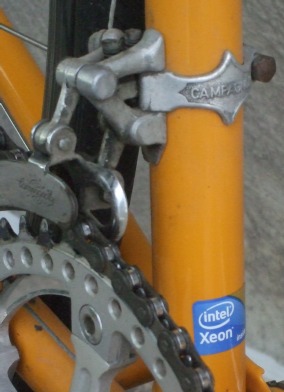May 2011 archive
Last year, the US Court of Appeals for the Ninth Circuit said it was OK
for government agents (without a warrant) to surreptitiously install a
GPS tracking device on a car while it was in the owner's driveway.
The decision notes that "the driveway had no gate, no 'No Trespassing' signs, and no features to prevent someone standing in the street from seeing the entire driveway. ... Thus, because Pineda-Moreno did not take steps to exclude passersby from his driveway, he cannot claim a reasonable expectation of privacy in it..."
 Sounds like I should post a sign in my driveway. Maybe one like this,
which says "This area is under video surveillance for the prevention of crimes
by the police". (The ambiguity works better in the German word order.)
Sounds like I should post a sign in my driveway. Maybe one like this,
which says "This area is under video surveillance for the prevention of crimes
by the police". (The ambiguity works better in the German word order.)
From a dissent in that case:
iFixit.com took one of the FBI's tracking devices apart and posted a nice report with pics and descriptions.
German sign pic by Eva K. used under CC BY-SA 2.5 license From a 2007 paper:
And I'm amused by how a snake is less symmetric internally than you or I. Snake kidneys, for example, are staggered to make better use of the available space.
I don't have a pic of my snake's innards to show you, but these are mine:
I was faced with a dilemma a couple days ago.
The details of the dilemma are irrelevant to the point I have in mind,
which is that I spent a bit of time agonizing over my choice.
As is so often the case, my recent dilemma required choosing between
unpleasant alternatives. But pleasant alternatives can also take a
while to choose from--even if the time passes more enjoyably.
How much time can it take to make a choice? In practice, a marble will not rest on a knife edge for long--but there remains a chance, however small, that it will balance for as long as a minute.
In considering what direction things fall in, Aristotle wrote of a man who "though exceedingly hungry and thirsty, and both equally, yet being equidistant from food and drink, is therefore bound to stay where he is...".
Computers are designed to not vacillate. A modern CPU makes billions of decisions every second, with every decision made in a timely manner.
Electricity, however, is not inherently digital. Voltages come in shades of gray. Where possible, digital logic is designed to ensure that each voltage representing a bit of data is comfortably above or below some threshold at the time a decision is to be made. A voltage will inevitably take on intermediate values as it rises or falls, but we can design circuits to pay attention only at regularly-scheduled moments when we've arranged for it to be steadily high or low. The timing is similar to how the shutter in a movie projector is synchronized with the mechanism that holds each frame still while it is projected.
But if a logic circuit tries to evaluate signals that are not arriving on a predictable schedule, all bets are off. It can take a while to make a decision. This is true no matter whether you build the circuit from transistors, relays, or marbles and hinges. Electrical engineers have techniques for managing the hazard of what they call metastability, but it is a tricky business.
Vacillation is not just a quirk of animal minds; it is a fundamental problem.
Happy nineteenth, everyone.

The decision notes that "the driveway had no gate, no 'No Trespassing' signs, and no features to prevent someone standing in the street from seeing the entire driveway. ... Thus, because Pineda-Moreno did not take steps to exclude passersby from his driveway, he cannot claim a reasonable expectation of privacy in it..."
 Sounds like I should post a sign in my driveway. Maybe one like this,
which says "This area is under video surveillance for the prevention of crimes
by the police". (The ambiguity works better in the German word order.)
Sounds like I should post a sign in my driveway. Maybe one like this,
which says "This area is under video surveillance for the prevention of crimes
by the police". (The ambiguity works better in the German word order.)
From a dissent in that case:
I don't think that most people in the United States would agree with the panel that someone who leaves his car parked in his driveway outside the door of his home invites people to crawl under it and attach a device that will track the vehicle's every movement and transmit that information to total strangers. There is something creepy and un-American about such clandestine and underhanded behavior. To those of us who have lived under a totalitarian regime, there is an eerie feeling of déjà vu.The DC Circuit also ruled on a GPS case last year. Unlike the Ninth Circuit, they found that the surveillance violated Fourth Amendment rights. The issue may well end up in the Supreme Court.
iFixit.com took one of the FBI's tracking devices apart and posted a nice report with pics and descriptions.
German sign pic by Eva K. used under CC BY-SA 2.5 license From a 2007 paper:
While viewing faces, human participants often demonstrate natural gaze bias towards the left visual field, that is the right side of the person's face is often inspected first and for a longer period. ...I'll leave it to others to speculate on whether the right side of a human face is more expressive than the left. I just want to say that I like an element of asymmetry in an otherwise symmetrical design. I like dogs with asymmetric markings. I like the asymmetric rear window (if not much else) of the Nissan Cube. I like the not-quite-symmetric serifs on the T in Garamond and similar typefaces (see the top of this page).
Domestic dogs, however, demonstrated left gaze bias only towards human faces, but not towards macaque or dog faces, nor symmetrical object images.
And I'm amused by how a snake is less symmetric internally than you or I. Snake kidneys, for example, are staggered to make better use of the available space.
I don't have a pic of my snake's innards to show you, but these are mine:
 |
|
"How does one art direct a cow?" Video here. Reminds me of what it took to get this pic. |
 |
How much time can it take to make a choice? In practice, a marble will not rest on a knife edge for long--but there remains a chance, however small, that it will balance for as long as a minute.
In considering what direction things fall in, Aristotle wrote of a man who "though exceedingly hungry and thirsty, and both equally, yet being equidistant from food and drink, is therefore bound to stay where he is...".
Computers are designed to not vacillate. A modern CPU makes billions of decisions every second, with every decision made in a timely manner.
Electricity, however, is not inherently digital. Voltages come in shades of gray. Where possible, digital logic is designed to ensure that each voltage representing a bit of data is comfortably above or below some threshold at the time a decision is to be made. A voltage will inevitably take on intermediate values as it rises or falls, but we can design circuits to pay attention only at regularly-scheduled moments when we've arranged for it to be steadily high or low. The timing is similar to how the shutter in a movie projector is synchronized with the mechanism that holds each frame still while it is projected.
But if a logic circuit tries to evaluate signals that are not arriving on a predictable schedule, all bets are off. It can take a while to make a decision. This is true no matter whether you build the circuit from transistors, relays, or marbles and hinges. Electrical engineers have techniques for managing the hazard of what they call metastability, but it is a tricky business.
Vacillation is not just a quirk of animal minds; it is a fundamental problem.
Happy nineteenth, everyone.
Does he look content, or what. |

| I love it. You buy a CPU,
and they throw in a sticker-- but it's only stickable under
license.
My response to Intel is the same as my response was to websters-online-dictionary .com (who have since taken the don't‑view‑this comment out of the HTML for their pages). It bears noting that the AMD Opteron sticker I put on my car was not so encumbered. |
 |
This is easy to remember, just watch the symmetry. When a man says "yes" he means "perhaps";
when he says "perhaps" he means "no";
when he says "no" he is no diplomat.When a lady says "no" she means "perhaps";
when she says "perhaps" she means "yes";
when she says "yes" she is no lady.- P. A. M. Dirac